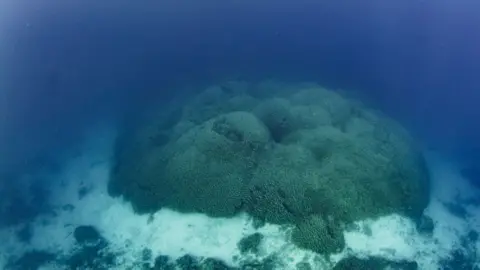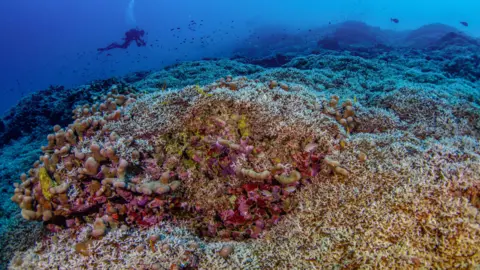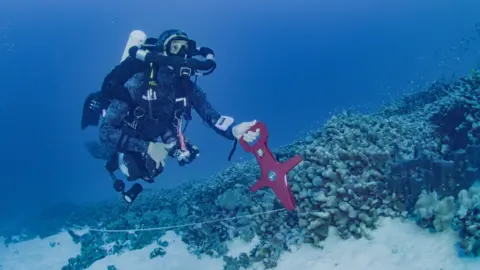[PHOTOS] World’s largest coral found in Pacific Ocean
Scientists have discovered the largest coral ever recorded in the southwest Pacific Ocean.
This colossal coral—composed of numerous tiny interconnected organisms forming a single large entity rather than a reef—is estimated to be over 300 years old.
According to the research team, it surpasses the size of a blue whale.
The coral was spotted by a videographer aboard a National Geographic expedition vessel exploring remote Pacific regions to study the impact of climate change.

“I went diving in a place where the map said there was a shipwreck and then I saw something,” said Manu San Felix.
He called over his diving buddy, who is also his son Inigo, and they dived further down to inspect it.
Seeing the coral, which is in the Solomon Islands, was like seeing a “cathedral underwater”, he said.
“It’s very emotional. I felt this huge respect for something that’s stayed in one place and survived for hundreds of years,” he said.
“I thought, ‘Wow, this was here when Napoleon was alive,’” he remarked.
Expedition scientists measured the coral underwater with a specialized tape measure, finding it to be 34 meters wide, 32 meters long, and 5.5 meters high.
Coral worldwide is under significant threat as ocean temperatures rise due to climate change.
Known as the “architects” of the seas, corals can connect to form extensive reefs that support diverse marine life.
According to the World Economic Forum, coral reefs are essential to the livelihoods of around one billion people, providing resources for tourism, fishing, and more.

This specimen was found in deeper waters than some coral reefs, which may have protected it from higher temperatures at the sea surface.
The discovery was announced at the same time as the UN climate talks COP29 in Baku, Azerbaijan that are trying to make progress in tackling climate change.
Mr Trevor Manemahaga, climate minister for the Solomon Islands at the summit, told BBC News that his nation would be proud of the newly-found coral.
“We want the world to know that this is a special place and it needs to be protected,” he said.
“We rely mostly on marine resources for economic survival so coral is very, very important […] And it’s very crucial and critical for our economy to make sure our coral is not exploited,” he said.
Small island nations like the Solomon Islands face extreme vulnerability to climate change.
Mr. Manemahaga shared that he has witnessed the direct impacts of global warming on his homeland, with increasingly intense cyclones and coastal erosion causing homes to collapse into the sea.

Many developing countries at the climate talks are urging wealthier nations to provide more financial support to implement their climate strategies.
Mr. Manemahaga emphasized that increased funding for the Solomon Islands would enable the country to create more diverse job opportunities, reducing dependence on industries that harm coral reefs.
Currently, logging accounts for 50-70% of the Solomon Islands’ annual export revenue, yet it generates significant water pollution that damages local coral ecosystems.
Eric Brown, who is a coral scientist on the National Geographic research trip, says that the health of the coral was “looking pretty good”.
“While the nearby shallow reefs were degraded due to warmer seas, witnessing this large healthy coral oasis in slightly deeper waters is a beacon of hope,” he said.
The coral, identified as Pavona clavus, serves as a habitat for shrimp, crabs, fish, and various other marine species.
Its age provides a unique glimpse into historical oceanic conditions, and scientists aim to study the coral’s growth patterns to gain insights into past environmental changes.
A recent report from the International Union for the Conservation of Nature revealed that 44% of warm-water coral species now face the threat of extinction—a rise of one-third since the last assessment in 2008.



